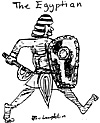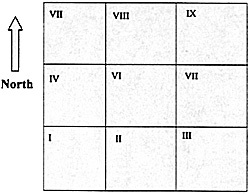 Readers, in September Jon Laughlin, who you will readily identify as the gamemaster of Volci, sent me the following e-mail: I have been running the Volci campaign for over 2 1/2 years now. It has been a lot of fun, but I feel that the time has come for me to put it at least on hold. I see a need to redesign it. Having run a full time wargames campaign I have come up with a lot of ideas for making it better, or even to design a new campaign. As a bare bones campaign Volci was perfect. Now what I want is to design a campaign that is a little more involved but more limited in scope. My next project will be an ancient Italian campaign. I am intrigued by the period. It is my intention to solo game it out first, and get involved in some other people's games, starting with Stuart Schoenbergers Great Northern War. I like the idea of being Peter the Great since I live so close to St. Petersburg, Florida.
Readers, in September Jon Laughlin, who you will readily identify as the gamemaster of Volci, sent me the following e-mail: I have been running the Volci campaign for over 2 1/2 years now. It has been a lot of fun, but I feel that the time has come for me to put it at least on hold. I see a need to redesign it. Having run a full time wargames campaign I have come up with a lot of ideas for making it better, or even to design a new campaign. As a bare bones campaign Volci was perfect. Now what I want is to design a campaign that is a little more involved but more limited in scope. My next project will be an ancient Italian campaign. I am intrigued by the period. It is my intention to solo game it out first, and get involved in some other people's games, starting with Stuart Schoenbergers Great Northern War. I like the idea of being Peter the Great since I live so close to St. Petersburg, Florida.
Jon, my heartiest congratulations for the successful conclusion of the Volci Campaign! I am certain that the players got a lot of enjoyment and that you are a better gamemaster for your efforts. Also, thank you for your final report which appears below.
Volci: 2 1/2 Years of Fun and Mayhem
Where does one start to describe such a venture? Such a campaign was always my ambition since reading Tony Bath's book Setting Up a Wargaming Campaign. With the Volci Campaign I had that chance. I never put as much detail into my campaign as he put into the Hyborean campaign, but I had loads of fun. He had 28 players in his campaign. I had 18 total but the average number of active players at any one time was 9. What I lacked in detailed records was more than made up by the game mastering skills I learned while playing D&D in part and the methods I developed in playing my solo wargame.
Central to the Volci campaign was the basic campaign move. Each offensive army needed a general. In one turn each army could move, invade a territory, fight as many battles as necessary, if victorious, lay siege to the territory, and if defeated retreat. On his turn move, a player could conduct diplomacy. I expected him to write letters to the countries he wanted to deal with by diplomatic methods. He could also try out anything else he wanted to do. One player wanted to build a wall around his country. I let him do it but told him it would take a year to complete the project, and it would be nothing more than a dirt ditch with wooden stakes set in it. Another player wanted to concentrate on improving his national economy. I saw nothing wrong with that, but I let him know that all the extra money would be spent on more luxuries for the nobility, and none of it would be spent on military expenditures. Needless to say, the player was not too happy with that, but since he was a Carthaginian I let him know later that if he acquired an overseas empire, he could earn more points to spend on his army.
One common mistake made by new players was the thought that they could get all the little non-player states to join their empire. A great empire of imposing power may be able to intimidate lesser states to submit, but not the aspiring new leader.
My favorite such incident was with the Spartans. Seeing the great size of the Macedonian Empire, the new Spartan player called a conference of all the neighboring states to form the Hawk Alliance. For several months all they did was bicker over who should be their leader. In a matter of fact, Plataea, another major state that bordered Sparta, allied itself with Macedonia. Sparta had to force its neighbors to join its alliance the old fashioned way, by conquest.
Another player came up with the idea of a magical standard that would boost the morale of his army in battle. I gave King Gwydion of Trent the Golden Dragon, the standard of the legendary King Arthur himself, at no extra cost.
 Several players wanted to develop spy agencies. Fred the Red of the Olseg Vikings
actually told me how he was going to organize and operate his spy agency. It was so realistic that I gave him the bonus of knowing the strengths of all the armies of the countries in his area, much to the discomfort of King Cuthbert of Elmet, who suffered many embarrassments from the hands of Fred the Red's spy agency. Other players had spies but none were as effective.
Several players wanted to develop spy agencies. Fred the Red of the Olseg Vikings
actually told me how he was going to organize and operate his spy agency. It was so realistic that I gave him the bonus of knowing the strengths of all the armies of the countries in his area, much to the discomfort of King Cuthbert of Elmet, who suffered many embarrassments from the hands of Fred the Red's spy agency. Other players had spies but none were as effective.
Another idea I tried to introduce was matrix gaming. Here by the use of logical argument a player can get another non player state to do his bidding. Ln the northwestern Viking area, the warring kingdoms of Elmet and Trent made the greater use of it. Both players did their best to make trouble for the other. King Cuthbert of Elmet was constantly having to put down rebellions while King Gwydion found himself being attacked by enemies from unexpected quarters. And it was all over control of the remains of the major Kingdom of Warwic. The next most effective user of the matrix gaming rules was king Alexandros of Macedon, when he got the Bitrigues to attack Aegina, and then the Semones to attack Elis.
New ideas were incorporated into the campaign. One of the most important was regenerating armies. With this a unit that rested for one month would regenerate 1/4 of its strength. I also let a player collect 1/2 a territory's value when it was conquered. These two rules were introduced to first reward active players and second to prevent active armies from wearing themselves out through active campaigning. These were the two most important rules additions in the Volci Campaign.
Another idea I would introduce would be not to let a player know what the morale class of his units would be. He would assume that his guard and noble units would have better morale than the regular units, and the regular units would have better morale than the militia units, but I would secretly determine their rating due to success or failure in battle.
Another idea I introduced to help players get more bang out of their buck was to give players reduced costs for troops that could be only used for defense. There was the regular army that could be used anywhere. Imperial defense units cost 3/4 normal cost and could be used anywhere in a player's empire, and extra militia that cost 1/2 price and were restricted to the homeland.
 The campaign was divided into 9 map areas. Five of them were active. Map I had Sparta, Macedon, and at times Roma. The war between Macedon and Sparta was the main player conflict there.
The campaign was divided into 9 map areas. Five of them were active. Map I had Sparta, Macedon, and at times Roma. The war between Macedon and Sparta was the main player conflict there.
Map II was the domain of Ashur and Carthego. They were quick to sign a non-aggression treaty and established a neutral zone between them. Map V was home to the Kingdom of Belgorod and the Caliphate of Shazam. Both powers spent the campaign expanding. Near the end, the Borsippan Empire was activated but did little (this empire was styled after the Byzantine Empire).
Map VI was the home of the mighty Tu Chu Empire. King K'Bong succeeded in uniting the Tibetan people under his leadership and at the end of the campaign was preparing to make war on the degenerate Han Empire.
Map VII at the start was the most crowded area. Active at one time or another were the Kingdoms of Laughlin, Kent, Olseg, Upsalla, Elmet, and Trent. Laughlin and Trent were Arthurian, Olseg and Upssala were Viking, and Elmet and Kent were Saxon. Ultimately it was the war bdween Elmet and Trent that influenced events of the nor~lands, drawing the other powers into their conflict.
So, What's next? First, I'm going to sort out my ideas and with the lessons Iearned put together a new campaign. Then I intend to solo play my ideas out, a little play testing, and then my new campaign. Right now I'm thinking of an ancient Italian campaign in the fifth or fourth centuries B.C. Now I need some good maps of ancient Italy.
Back to Table of Contents -- Lone Warrior #124
Back to Lone Warrior List of Issues
Back to MagWeb Magazine List
© Copyright 1998 by Solo Wargamers Association.
This article appears in MagWeb (Magazine Web) on the Internet World Wide Web.
Other military history articles and gaming articles are available at http://www.magweb.com
